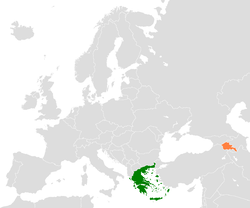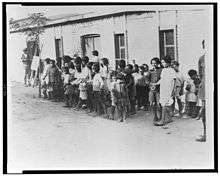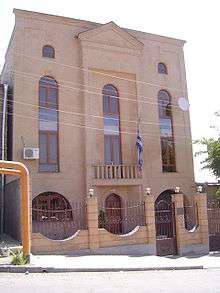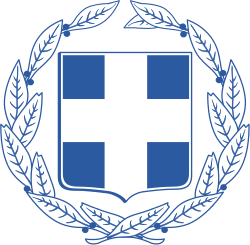Armenia–Greece relations
 |
|
Greece |
Armenia |
|---|---|
Greco-Armenian relations refer to the bilateral relations between Armenia and Greece. Due to the strong political, cultural and religious ties between the two nations, (the vast majority of Armenians and Greeks practice the Eastern Christian faith), Armenia and Greece today enjoy excellent diplomatic relations. They have always been strong both emotionally and historically due to religious and cultural roots and co-existence during the Byzantine and Ottoman Empires.
Names
In the Greek language, Armenia is called Αρμενία (Armenia), the Armenians are called Αρμένιοι (Armenii) and the Armenian language is called αρμένικα (Armenica). In the Armenian language, Greece is called Հունաստան (Hounastan), the Greeks are called հույներ (Houyner) and the Greek language is called Հունարեն (Hounaren). The Greek transcription of the Armenian word for Armenia (Հայաստան) is Χαγιαστάν (Hayiastan). The Armenian transcription of the Greek word for the Greek language (Ελληνικά ) is էլլինիկա.[1]
History



Both being ancient civilizations, Armenians and Greeks have co-existed for centuries. There are ancient notes by Greek historians suggesting of the roots of Armenians. The earliest reference to Armenia was made by the Greek historian Hecataeus of Miletus in 525 BC.[2] According to a hypothesis proposed by linguists during the 20th century, the Armenian and Greek languages share a common ancestor. This has led to the proposal of a Graeco-Armenian language, post-dating the Proto-Indo-European language. Herodotus suggests that the Armenians are descendants of the Phrygians. Plato had early noticed the similarities between the Greek and the Phrygian languages. In addition Strabo has written that the ancestral homeland of the Armenians or of their ruling class, prior to their immigration in Asia Minor, was a valley in Thessaly, after which they are named. A chain of ancient references that show the close relation between the two peoples.
After the destruction of the Seleucid Empire, a Hellenistic Greek successor state of Alexander the Great's short-lived empire, a Hellenistic Armenian state was founded in 190 BC.

The Armenian language is said to be influenced from Ancient Greek, but both languages developed differently over time.
The Armenian alphabet (created in 405), being written from left to right and not from right to left like other scripts of the Mediterranean Basin or Middle East, has a certain Greek flavour.
During the Byzantine Empire's era, Armenians and Greeks co-existed in relative peace thanks to their religious ties. Armenians constituted an integral part of the Empire in its early centuries, with many of the Byzantine Emperors being Armenian and/or having Armenian blood. The Macedonian Dynasty is often considered the era in which the Byzantine Empire reached its greatest extent since the Muslim Conquests and the Macedonian Renaissance in letters and arts began. The dynasty was named after its founder, Basil I the Macedonian, who was descended from the theme of Macedonia (the theme was actually located in the region of Thrace, and had no relation with the geographical region of Macedonia). The dynasty's founder and many subsequent emperors were of Armenian descent, hence the dynasty is also referred to by some authors as the "Armenian Dynasty".[3] However, because of the differences that existed between Greek Orthodox and Armenian Apostolic Christianity, Byzantine emperors often tried to conquer the Armenian Bagratuni Dynasty Kingdom and impose Greek Orthodoxy. They achieved this in 1045 after many attempts. This weakened both Byzantines and Armenians alike, and in consequence, they weren't able to keep the Turks away from Armenia who left it undefended (1064) and from the rest of Anatolia (1071 onwards)
Regardless, these two nations also co-existed under Seljuk and later Ottoman empire.
Today
Political relations

Greece was one of the first countries to recognize Armenia's independence on September 21, 1991.[4] Both countries have an embassy in their respective capitals. Also, Greece is one of the countries that have officially recognized the Armenian Genocide and is one of the few countries that has criminalized the denial of the Genocide.[5]
Since the declaration of independence in Armenia, the two countries have been partners within the framework of international organizations (United Nations, Organization for Security and Co-operation in Europe, Council of Europe, BSEC), whilst Greece firmly supports the community programs aimed at further developing relations between the European Union and Armenia.
Continuous visits of the highest level have shown that both countries want to continue to improve the levels of friendship and cooperation (Visit by the President of Armenia Levon Ter-Petrossian to Greece in 1996, visit by the President of Greece Costis Stephanopoulos in 1999, visit by the President of Armenia Robert Kocharyan to Greece in 2000 and 2005).
Military cooperation
Greece is, after Russia, one of the major military partners of Armenia. Armenian officers are trained in Greek military academies, and various technical assistance is supplied by Greece. Since 2003, an Armenian platoon has been deployed in Kosovo as part of KFOR. There they operate as a part of the Greek battalion of KFOR. In 2011 Armenia’s military attaché to Greece and Cyprus, Colonel Samvel Ramazyan, said that the Armenian-Greek military cooperation continues to steadily develop.[6]
Treaties
Both countries have signed bilateral treaties which include:
- Economic, Industrial and Technological Cooperation Agreement (in force since 1 December 1994)
- Agreement on the Promotion and Mutual Protection of Investments (in force since 28 April 1995)[7]
- Cooperation Agreement in the military sector (June 1996)
- Agreement on Avoidance of Double Taxation on Income (in force since 13 May 1999)
Diasporas
Estimates on the size of the Greek community in Armenia range from 1,800 to 5,000 . The declining number of Greeks in Armenia in recent years is mainly due to mass migration to Greece from the former Soviet Union and because of Armenia's economic situation as a result of the Nagorno-Karabakh War.[4] It was further exacerbated by the Leninakan earthquake which in December 1988 struck northwestern Armenia, the area where most of the Greeks used to live. The largest Greek communities are in Yerevan and Alaverdi, followed by Vanadzor, Gyumri, Stepanavan and Noyemberyan.
The Armenian community in Greece is much larger, numbering about 50,000 . The number was even higher but migration to North America has caused an evident reduction. The largest Armenian communities are in Athens and Thessaloniki.
See also
References
- ↑ "Google Translate". translate.google.com. Retrieved 2015-11-29.
- ↑ Chahin, Mark (2001). The Kingdom of Armenia. London: Routledge. p. 177. ISBN 0-7007-1452-9.
- ↑ Chahin, Mack. The Kingdom of Armenia: A History. London: RoutledgeCurzon, 2001, p. 232 ISBN 0-7007-1452-9
- 1 2 "Greece's Bilateral Relations". www.mfa.gr. Retrieved 2015-11-29.
- ↑ "There took place Armenian-Greek high-level negotiations in Presidential Palace - Press releases - Updates - The President of the Republic of Armenia [the official site]". www.president.am. Retrieved 2015-11-29.
- ↑ "In Greece, diplomatic military corps marks Armenian Army Day (PHOTO)". news.am. Retrieved 2015-11-29.
- ↑ "Armenia - Bilateral Investment Treaties (BITs)". investmentpolicyhub.unctad.org. Retrieved 2015-11-29.

